One sheet will be for milk chocolate, the other semisweet. (Russell Steven Powell)
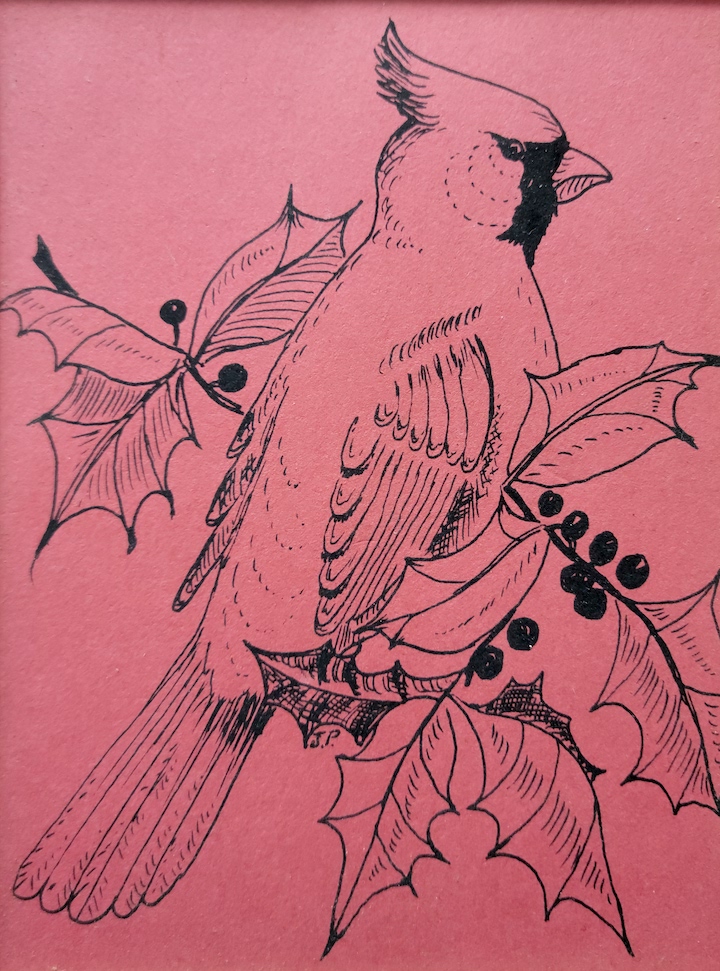
MY MOTHER WAS A WHIRLWIND of activity around Christmas.
In addition to teaching school and the daily cleaning and cooking for four messy and ravenous boys, she somehow managed to paint a holiday scene on the post office’s large front window on Central Street, using a mix of poster paint and Glass Wax, and every other year drew a design for our family Christmas card, alternating with my father.
One year she braided and baked a dozen of her delicately sweet cardamom coffee breads, giving them to the mailman, the milkman, and neighbors in addition to the two we wolfed down on Christmas morning.
(I loved the moist bread, topped with a thin icing flavored with almond extract and topped with finely ground walnuts and a candied cherry or two. With half a grapefruit with a maraschino cherry in the middle, this was our breakfast before opening presents.)
And my mother made candy. Lots of it. Spread out on the chest freezer opposite the pantry on one end of the kitchen were peanut brittle and butterscotch drops, and several types of fudge: chocolate, of course, and glossy white divinity with half a candied cherry in the middle (which I loved), and penuche (too granular and sweet, even with walnuts).
But this treasure trove of candy was not for us. It was for a reclusive, Mrs. Havisham-like figure, with the Dickensian name of Mrs. Means, my grandfather’s elderly employer. Owner of a 1,000-acre farm of Morgan horses, Jersey cows, and apple orchards, she was certainly a person of means.
Her regal bearing suggested meanness, too, though I never had a bad experience with her. She lived in a massive house with a massive front lawn that we passed on our way to the farmhouse at Elm Hill Farm, where my Mom grew up and she and my Dad were married on the front lawn.
Mrs. Means struck me as a lonely, imposing, slightly scary figure. I rarely saw her, but occasionally she would be out walking on her lawn, frail but imperious, dressed in black, face shaded beneath a broad-brimmed hat.
Around Christmas, we were occasionally invited into the house by Mrs. Means’s son, Blanchard, already an older man himself, heavy lipped, gruff and self-important, befitting a professor with large glasses, vest, and tweed. The visits were short, and I have no memory of the old lady being there.
We were often at Elm Hill, though, visiting my grandfather, who lived there in retirement after managing the farm for many years. Those rare glimpses of Mrs. Means in funereal black and brief times in her mansion were the extent of our contact with the Means family growing up.
But evidently Mrs. Means had a sweet tooth. I never knew what started my mother’s candy-making for her, or when it began. Perhaps she was carrying on a tradition of her late mother’s, who died the year I was born.
But unlike her generous coffee breads and Christmas designs, the candy seemed to be made out of a sense of obligation. I sensed that my mother felt a mix of resentment and fealty to Mrs. Means that lent the sweet candy a hint of bitterness.
* * *
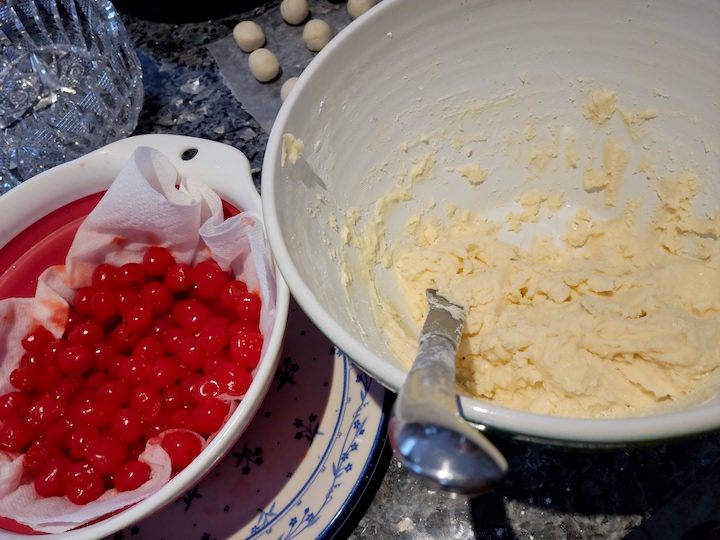
MY SWEET TOOTH is nowhere near as strong now as it was when I was young. I have always loved sweets, and I trace it primarily to my mother, who could devour an angel cake in 24 hours well into her 90s, and at age 100 still enjoys her Milky Ways.
My first foray into candy-making was an easy one, chocolate-covered raisins. Beginning around age 12, I made them for several years.
Melt a bag of chocolate chips in a double boiler, stir in a can of sweetened condensed milk, add a box of raisins, and spoon them into clusters on wax paper. That’s it!
The Cadillac of candies for me, though, were always chocolate-covered cherries, sweet, gooey exotic treats that we only had at Christmas. The whole family loved them, and well into adulthood my mother and brothers exchanged boxes of store-bought ones every year.
One December when my daughter was still in elementary school, I decided to surprise her and her mother by making a variety of candies for Christmas, like my mother had for Mrs. Means (without the bitterness). Except for my chocolate-covered raisins, I had never made candy before, and I had to do my cooking in secret, late at night, after the two of them had gone to bed.
But I had fun and learned a lot. I poured hot peanut brittle on a cold marble slab in the cellar and watch it almost instantly harden. I simmered almonds in a sugary cinnamon bath, burned the first batch, and made them again, adding red food coloring.
I made chocolate fudge and divinity, the latter requiring lots of stirring and just the right atmosphere to thicken. I even made chocolate-covered raisins.
The gift was a huge hit, so much so that I decided to do it again the following year, keeping the most popular candies and refining the list (neither peanut brittle nor sugared almonds made the cut).
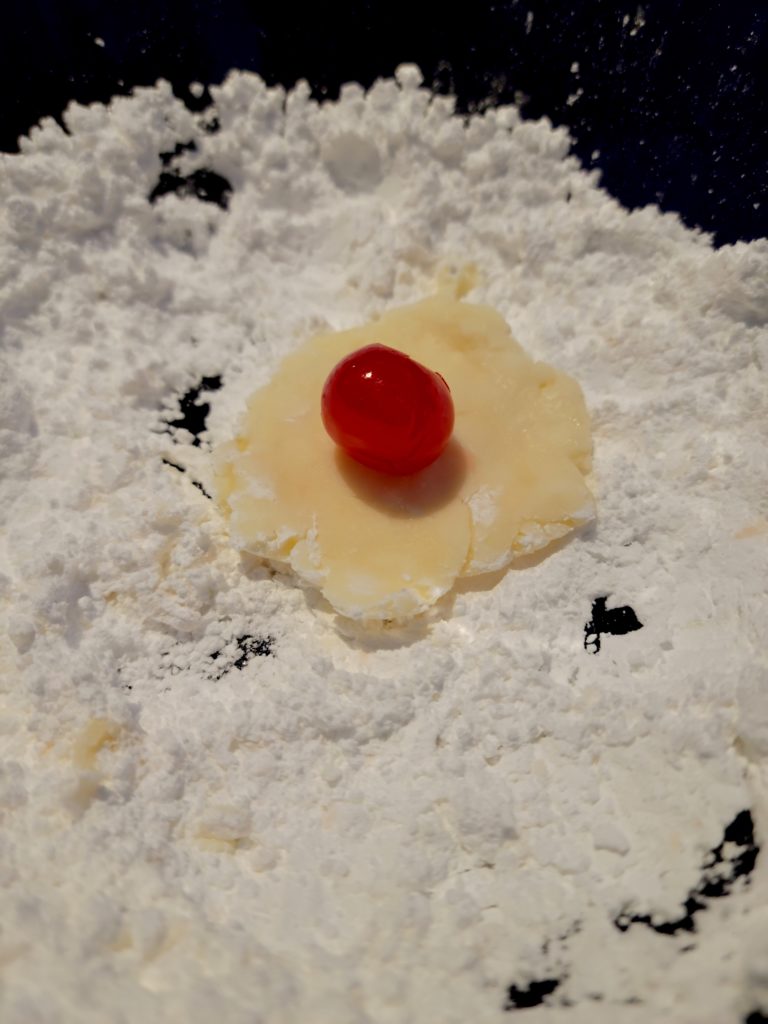
Around the third year, while searching for cookie recipes in the 1934 Hershey’s Cookbook, I stumbled across a recipe for Chocolate Cherry Cordials. I immediately forgot about cookies and made the cherries, and added them to that year’s mix.
The verdict was swift and unanimous. No more mix! From now on, make only Chocolate Covered Cherries. It has been that way ever since, more than 30 years later.
There have been innovations along the way. When my daughter and I made them together during her teenage years, she perfected a method for wrapping the creamy confection around the cherry that I use to this day.
At first, I used only dark, semisweet chocolate, but soon I began to make half milk chocolate since many people have strong preferences for one kind or the other.
I dramatically scaled the original recipe up to accommodate the increased demand for these rich, delectable treats.
Like my mother’s coffee breads, I eat some but mostly give them away.
* * *
Chocolate Covered Cherries
(makes 100-plus cherries)
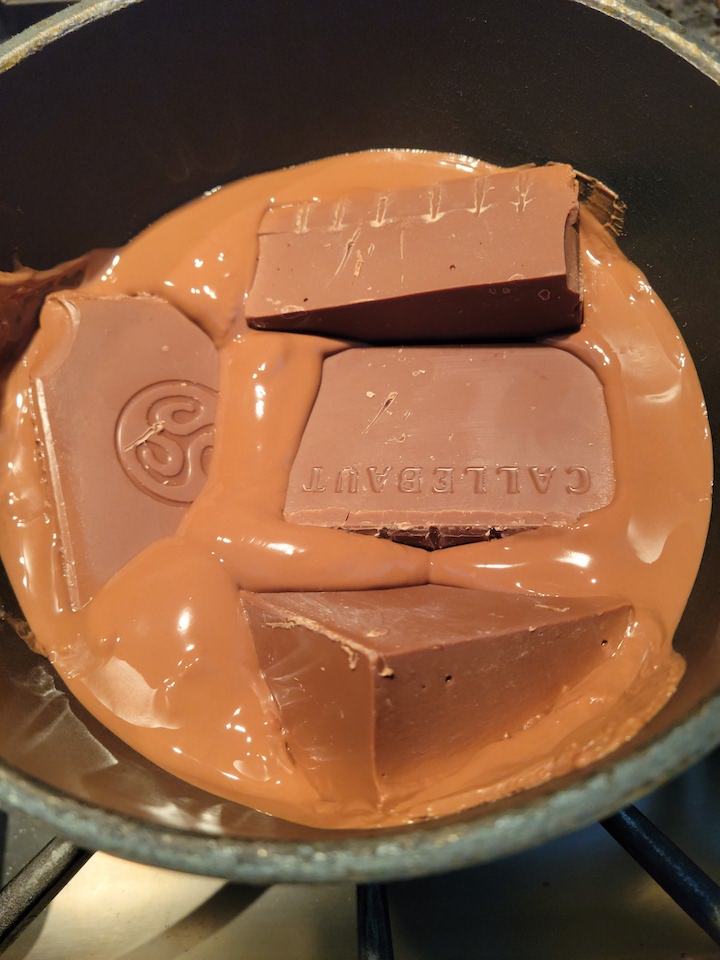
3 16 oz. jars unstemmed maraschino cherries
approx 1 lb Callebaut or other fine milk chocolate
approx 1 lb Callebaut or other fine semisweet chocolate
2 boxes confectioner’s sugar, plus ½ c
1 c butter, softened
4-5 T milk
2 t vanilla
1 t almond extract
Put on your favorite holiday music
Work with a friend or loved one (optional)
Drain and rinse cherries in colander. Transfer to another bowl, and place a paper towel folded in half in the colander.
Add cherries back in. Placed another paper towel on top and press lightly down to dry. Set aside.
Cream together butter and 2 c sugar, then add milk, vanilla, and almond extract. Stir until smooth.
Spread out two long sheets of wax paper
Add ½ c confectioners sugar to a small bowl
Take a small square of confection and drop it in the bowl of sugar. Remove it and gently flatten it between thumb and finger until it is thin and about the size of a half dollar.
Place a cherry in the middle and wrap the confection around it.
Crimp the seams together and softly roll the coated cherry into a smooth ball. If the cherry leaks or the confection is too soft to roll just drop it back in the sugar.

Place on wax paper, six to a row.
(Don’t worry if they aren’t all perfect or look the same. Like steam engines and snowflakes, no two cherries are the same. The idea is to completely cover each one, but if a little cherry peeks through it won’t matter, since it will be drenched in chocolate.)
Repeat 100 times or more.
I always plan to make at least 100 candies, but the number of cherries listed in a jar is typically on the low side. This year, for example, the label on the 16-ounce jar says that there are 36 cherries per jar, so I used three jars, or 108 in all. I ended up making 138 candies before I ran out of confection, with plenty of cherries left over.
No matter how many or how few, rolling out the cherries is the most time-consuming part of the process. Some would call it tedious, but to me it is pleasant and contemplative, the essence of the experience that infuses the candy with a personal touch and the warmth of the season.
When the cherries are all covered in the buttery confection and rolled into balls, it’s time to melt the chocolate, slowly, in double boilers if you have them, or if not (like me), in saucepans over the lowest possible heat.
I always choose the best chocolate — no sense going to all this effort otherwise — and there’s nothing worse than burning it even slightly or having it stick to the pan. I don’t leave the room and I frequently stir the melting chocolate blocks with a fork until the last piece has dissolved.
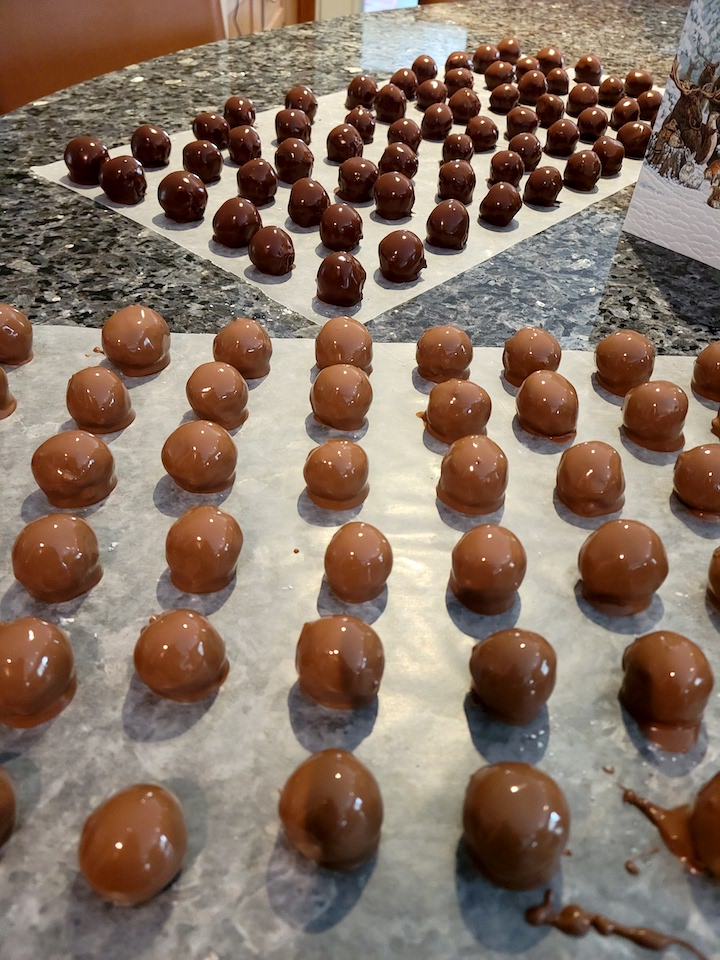
When the chocolate is melted, the dipping starts.
One by one I drop a coated cherry in the melted chocolate, fish it out with the fork, scrape the side of the pan to keep the chocolate from dripping, and gently slide the cherry on to the wax paper, milk chocolate on one sheet and semisweet on the other.
The cherries dry for several hours, until they lose their sheen. Invariably, there are flaws where the fork’s tines show through, or on the bottom, where a white spot needs covering up.
I remelt the chocolate and patch each cherry, moving quickly, with a teaspoon instead of the fork.
When the patched cherries dry, they are done! The original recipe says eventually they are supposed to liquify, but mine never do. Maybe it’s because they don’t last long enough.
In any case, the chocolate begins to mysteriously break down slightly after a week or two. Maybe it has to do with heating the chocolate, or else the chocolate is corrupted by the inevitable stray grains of confectioner’s sugar during the dipping.
Whatever the reason, while untouched chocolate can last for years, the cherry coating eventually dulls and starts to become softer and brittle. Like most foods considered perishable, they are best enjoyed fresh.
* * *
THE FINAL STEP (other than packing) is what to do with the leftover chocolate. It’s too plentiful and too good to throw away. Instead, I make what I call brickle.
I line two cookie sheets with wax paper, then add different flavors and textures to each saucepan of still-melted chocolate.
It’s always different. This year, for instance, I added rice crispies, dried cherries, and salted nuts to the milk chocolate. To the semisweet, I stirred in cherries and cranberries, cornflakes and those puffy, peanut-butter pretzels.
I’ve used coconut and pecans, apricots and raisins. Each batch is both savory and sweet. No two years are the same.
I spread the mixes out on the wax paper in their respective trays as thin as I can and put them in a cool place to harden.
Lifting out the wax paper onto a cutting board, I cut the brickle into bite-sized pieces of the same great chocolate. Voila.
That’s it until next year.


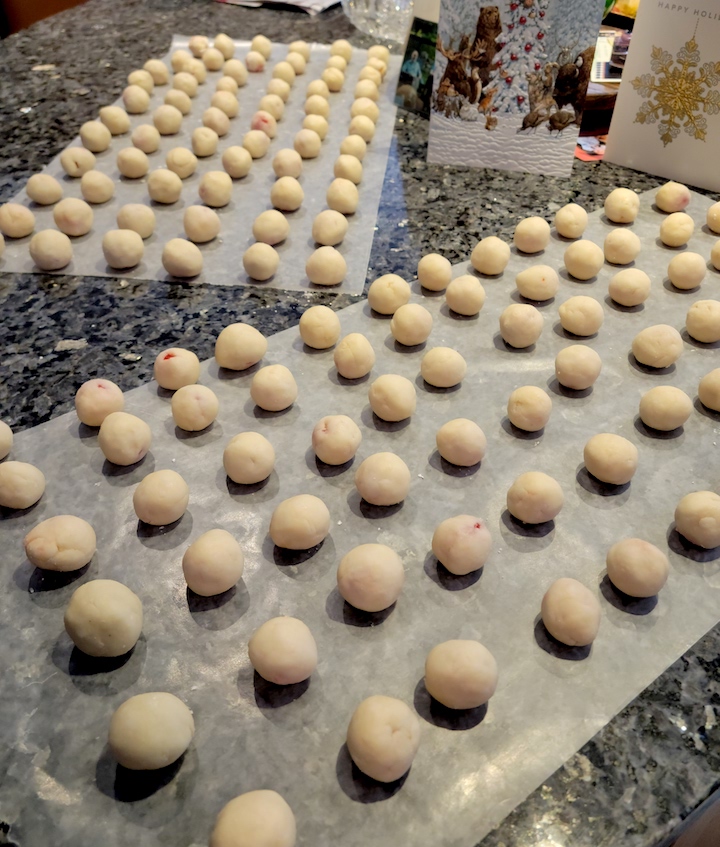
I had no intention of reading this entire email, I opened it while doing something that I thought was very important. But the story captured me and I read it to the end standing in the middle of the kitchen not thinking a moment about what I was supposed to be doing. Stirring up lots of childhood memories, my own family candymaking and capturing a precious memory of what Christmas is about (at least for me), I enjoyed reading the entire story. And I’m very happy to have the recipes. Thanks Russell. Happy new year.
Thank you so much for this. A great compliment. It made my day! I’d love to hear about your own trials by candy!! Happy New Year!
I’m going to make chocolate covered raisins! They don’t look hard to do!
OMG, thank you for this inspiration, because I love chocolate covered raisins.
Thank you, Christine. They are not as fancy as chocolate covered cherries, but for me chocolate covered raisins are a close second. Chocolate and fruit–an unbeatable combination!! Happy New Year to Bill and you.
Happy Holidays Russell (and Barr!)
Same to you, Arch! May 2023 be bursting at the seams with fresh artwork. Happy printing.
A wonderful story and recipe. Michael and I have lovely memories of your chocolate covered cherries and your creative generosities.
A lovely comment from a lovely friend. Thanks so much. Miss you!